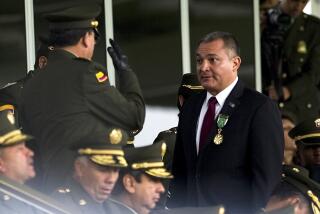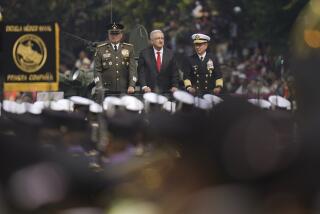Cartel Used Papal Envoy, Book Relates
MEXICO CITY — The Arellano Felix brothers used the papal nuncio as a personal emissary to request a meeting with President Carlos Salinas de Gortari to plead their innocence in the May 1993 killing of Cardinal Juan Jesus Posadas Ocampo at the Guadalajara airport, according to a new book.
And although Salinas knew that Ramon Arellano Felix was in the nuncio’s Mexico City residence awaiting his answer, he and his attorney general, the author of the book, decided not to have him arrested because the prospect was too risky, a possible trap that could cost the lives of the nuncio, who is the Vatican’s envoy, and other clerics. Those disclosures are included in the book by former Atty. Gen. Jorge Carpizo MacGregor, now a researcher at Mexico’s National Autonomous University. Carpizo also served as Salinas’ interior minister.
Titled “Killing of a Cardinal” and cowritten by Julian Andrade, the book hit bookstores Monday and is the most detailed and authoritative account yet of the cleric’s murder, which nine years later continues to generate suspicion, controversy and conspiracy theories.
The book also provides richly detailed descriptions of the pervasive corruption that the Arellano Felix gang and other drug cartels have engendered in Mexican government, police forces and, the authors allege, corners of the Roman Catholic Church. It provides gory details of the long-standing and bloody feuds between drug gangs that may have been at the root of the February killing of Ramon Arellano Felix in Mazatlan. U.S. officials believe that Ramon, the cartel’s enforcer, was “executed” by police acting at the behest of drug kingpin Ismael Zambada.
“I have never shirked my responsibility to say the truth when I occupied a public position. And the truth is that the corruption of these drug networks is not just Mexico’s problem but that of the entire world,” said Carpizo, 58, who has written 11 other books.
Posadas Ocampo was shot 14 times in the parking lot of the Guadalajara airport, his car mistaken by Arellano Felix hit men for a car owned by Sinaloa drug king Joaquin “El Chapo” Guzman. At least that’s the official conclusion, reached by three separate federal investigations, including Carpizo’s.
Skeptics--who include Posadas Ocampo’s successor, Cardinal Juan Sandoval Iniguez, and the Mexican council of bishops--say the government either botched the investigations or is covering up for the real killers. Church officials are pressuring the government to reopen the case.
The cardinal’s slaying--and now the book--are windows on Mexicans’ attitudes toward their government and conspiracy theories. Although no solid evidence supports a plot, many here are convinced that there was one. Carpizo is an apologist for the real killers to some, a fearless guardian of truth to others.
Jorge Chabat, an international relations professor at the Center for Economic Research and Teaching here, said conspiracy theories come naturally to Mexicans, who for decades have lived in a country where there is “no transparency, no accountability.”
“Sometimes, a plot is the only way to understand something in Mexico because there are so many strange things happening here,” Chabat said. “I don’t believe that the cardinal was killed as a result of confusion. There probably was a plot. It’s that no one knows who organized it.”
Disagreeing is Roberto Blancarte, a professor and religion expert at Colegio de Mexico here, who says no convincing scenario has been put forth to support a conspiracy theory. The durability of conspiracy theories merely proves Mexicans’ suspicions about justice, he said.
“I have always wondered why, without any evidence, Cardinal Sandoval sticks to disagreeing with the attorney general’s finding,” Blancarte said. “Maybe he doesn’t want to back away from his first denunciation, or this issue is helping him consolidate his position in the Mexican church.” Sandoval was not available for comment Monday but has vigorously maintained his call for a new investigation.
In an interview, Carpizo recounted the surreal night in December 1993 when he was called to a meeting at the presidential residence Los Pinos with Salinas and the Vatican’s representative in Mexico, Girolamo Prigione.
Hardly believing his ears, Carpizo was told by Prigione that Ramon Arellano Felix, who was considered among the country’s most dangerous criminals, was in the nuncio’s residence in Mexico City minutes away, awaiting an answer to his request to meet with Salinas.
Salinas, at Carpizo’s urging, turned down the request. Then after the papal representative invoked diplomatic immunity, he and Carpizo decided not to have Arellano Felix arrested, partly because of the violence it would involve and partly because Carpizo wasn’t sure he could mount an effective operation in the few minutes he had.
In his book, Carpizo claims that evidence shows cartel chief Ramon Arellano Felix and his brother Javier were at the airport during the shootout. He accuses a Tijuana priest, Gerardo Montano, who arranged Ramon Arellano Felix’s meeting with the nuncio, of giving Ramon an alibi on the day of the murder by falsifying a Tijuana baptismal record to show they were present.
Montano in recent days has publicly denied that he did anything wrong. He told reporters that he assisted the gang in his duties as a priest and as a favor to his childhood friend, Ruth Arellano Felix, the wife of Benjamin. Carpizo maintains that Montano committed a crime by not turning the Arellano Felix brothers in to police.
Kraul reported from Mexico City and Rotella from Paris.
More to Read
Sign up for Essential California
The most important California stories and recommendations in your inbox every morning.
You may occasionally receive promotional content from the Los Angeles Times.










